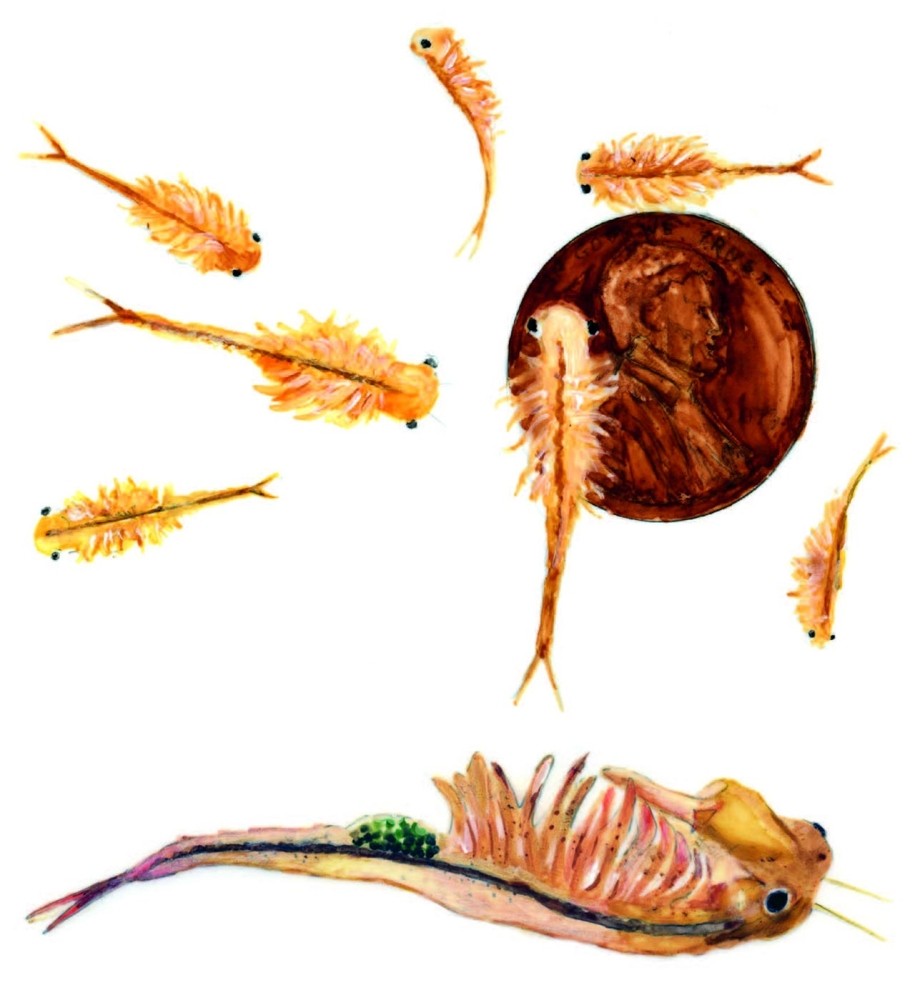
More than 400 million years ago, when invertebrates ruled Ordovician seas, the Anostraca, or fairy shrimp, evolved within the branchiopod crustaceans. They moved from oceans up through estuaries to then predator-free freshwater habitats. And despite five global extinctions since then, which ushered out trilobites and dinosaurs, you can still find these remarkable creatures in temporary wetlands throughout the Northeast.
If you picked up a Jurassic fairy shrimp fossil, you might be struck by its similarity to modern fairy shrimp. But that is not to say that these “living fossils” have not evolved. In fact, biologists have examined fairy shrimp genomes to track their evolution from ancestors that occupied the super continent Gondwanaland to current groups in Africa, North and South America, and Australia. Fairy shrimp are found on all continents from the middle of the Sahara to Greenland and Antarctica.
They have gossamer-thin bodies and compound eyes that sprout cartoonishly on stalks from the head along with a central ocellus that detects light, and two pairs of antennae. Behind the head, 11 pairs of limbs are attached to the thoracic segments, and each leg has attached gills. This leg/gill arrangement is shared with others of their class, inspiring the name Branchiopoda. Behind the thorax is a slender abdomen terminating in a pair of lobes.
Comic book advertisements in the 1960s and ’70s, encouraged an entire generation of kids to hatch fairy shrimp at home. Marketed as “sea monkeys,” salt-loving fairy shrimp in the family Artemia live in saline water bodies such as the Great Salt Lake and rapidly hatch in salty water. In addition to spawning a comic-book-reader-funded cottage industry, Artemia shrimp ease of hatching and rearing continues to produce research and educational projects that yielded nearly 5,000 publications in 2023 alone.
Vermont is a long way from the Great Salt Lake, but three less salty fairy shrimp species and cousins of sea monkeys can be found backstroking about in New England’s vernal pools. Their belly-up swimming style is powered by stadium-wave leg movements providing propulsion while simultaneously moving fresh water past their gills.
Fairy shrimp predators include diving beetles, salamanders, and dragonfly larvae, but because vernal pools dry out each year, they’re mostly spared from fish predation. Occupying habitats that dry out yearly is not without complications, and fairy shrimp life cycles have adapted to compensate. They hatch; feed on bacteria, plankton, and organic material; grow rapidly; and reach adulthood in about 20 days. At maturity, males use modified antennae to clasp available females. Unless the female rejects the male’s amorous advances by unceremoniously shaking him loose, the couple will produce resting eggs (also called cysts) that resist desiccation and hatch when the conditions are right. This arrangement allows fairy shrimp to ride out dry conditions and even brush fires for years to decades. “Just add water” works for sea monkeys, and spring rains and snow melt filling vernal pools does the trick for our local fairy shrimp.
The spherical eggs are smaller than the period at the end of this sentence, with shell surfaces that vary by species. Some are smooth, others spikey, some dimpled like miniature golf balls, one looks like a brain, and the ones sitting on my microscope as I type are covered with little polygons like soccer balls awaiting the smallest of strikers to kick them into the back of a very, very small net. Richard Hill and William Shepard of the California Academy of Sciences wrote that the shells of these eggs seem to be a compromise between protecting the embryos from UV light, abrasion, and crush damage, and the need to absorb water for rehydration. Because the eggs are tiny and light, they can be dispersed on mammal and bird feet or even be blown by wind to locations that may or may not get flooded at some future time.
Participants in the 2023 Burning Man fiasco witnessed this phenomenon firsthand. Because intense rain flooded the Nevada event, resting fairy shrimp eggs sitting in the desert hatched in large numbers, providing an additional experience for the participants. Newspaper accounts described large hatches of fairy shrimp and their far distant relatives, the tadpole shrimp, in pools of water as various major and minor celebrities waded past.
If you’d like to see some fairy shrimp, and assuming that Burning Man is not your thing, take a fine-mesh net or kitchen strainer to your nearest vernal pools. Transfer your catch to a water-filled pail for optimal viewing. You may have to search several pools to find some. To speed up your search, consider installing the iNaturalist app on your phone and go to places where others have found fairy shrimp before. Look also at when they found them to best time your visit. If successful, you can add “living fossil” to the list of cool beasties you have encountered. Release the fairy shrimp where you found them, and tell your local conservation commission of your find to help these remarkable invertebrates survive the next 400 million years…or so.

